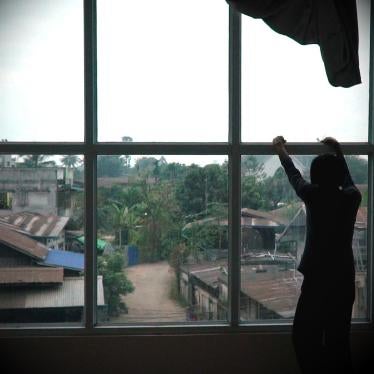阅读这支影片的文字描述
Beirut, Lebanon
After Beirut was devastated by the August 4 explosion at the port, tens of thousands of protestors gathered in the city to express their rage and frustration over the government’s incompetence and corruption.
This video contains graphic and disturbing images. Viewer discretion advised.
Lebanese security forces used excessive and at times lethal force against mostly peaceful protestors. On August 8, Human Rights Watch witnessed beatings and assaults and were themselves mistreated by security forces ourselves.
Human Rights Watch also documented the use of live ammunition against protestors.
In this incident, security forces fired multiple live rounds at protestors as they rescued an injured man. Potentially lethal force like this should not be used unless required to protect life.
We know these were live rounds because Human Rights Watch went to the site. We found the bursts seen here in the video match the new bullet damage on the wall.
And here a soldier from the Lebanese army fires six shots from his assault rifle in the direction of the Al Amin mosque where hundreds of protestors had gathered.
For the first time, Human Rights Watch documented the use of shotgun-fired metal pellets by Lebanese security forces. These “birdshot” cartridges fired from shotguns can contain hundreds of pellets in a single round. Metal pellets were the main cause of serious injuries to protesters’ eyes and vital organs.
“Birdshot” spreads out after being fired. t many of the victims we saw were shot at close range, with dozens of pellets embedded in their bodies.
The pellets can lead to chronic pain, fatigue, nerve damage, and other serious health effects. .
Security forces also fired rubber balls at protestors, aiming at their faces, heads and necks.
Security forces launched large volumes of tear gas in downtown Beirut. One grenade, the G1 CS, is designed to be fired 200 meters and is capable of dispersing tear gas over 800 to 1,000 square meters. Around Martyr’s Square, security forces fired it directly at ambulances and health workers caring for injured protesters.
Dr, Mouin Jammal
You see someone who is providing aid, wearing a uniform, treating a bleeding wounded person, and you throw a tear gas grenade at him? Are these really soldiers?
International norms state that tear gas should be fired from a high angle and only be used to disperse unlawful or violent assemblies.
Human Rights Watch observed security forces firing tear gas cartridges directly at protesters’ heads and torsos. This woman was hit by one in the shoulder.
All Lebanese security forces have denied shooting at protestors with live ammunition. But the evidence proves otherwise.
Security forces should immediately suspend the use of shotgun-fired metal pellets and other similar ammunition. The public prosecutor should open an independent investigation into the unlawful use of force.
International donors to Lebanon’s security forces should investigate whether their support is going to abusive units, and if so, halt it immediately.
(贝鲁特)- 黎巴嫩保安部队2020年8月8日在贝鲁特市中心使用过度且有时致命的武力对付大体和平的示威者。
保安部队发射实弹、钢珠弹和橡胶球等动能打击投射物(kinetic impact projectiles),包括对医护人员;警察动用过量的催泪瓦斯,包括对急救站。数枚催泪弹直接射向示威者,有些人头部、颈部中弹。保安部队还投掷石块、殴打示威者。在场部队包括国会警察、国内保安部队(ISF)、黎巴嫩国军(LAF)和身份不明的便服士兵。
“巴鲁特市民还在为大爆炸善后,黎巴嫩安全机关没有伸出援手,反而以惊人程度的暴力对示威者铁腕镇压,” 人权观察中东副主任麦可・佩吉(Michael Page)说。“动用如此非法且过度的武力对付大体和平的示威者,显见当局对自己的人民多么冷酷无情。”
数万名示威者8月8日聚集在贝鲁特市中心,表达对政府和政治菁英无能与贪腐的愤怒。人民普遍认为政治菁英必须为8月4日贝鲁特港区大爆炸负责,这次事故造成180人死亡、6,000余人受伤,全市严重受损。
人权观察研究人员在贝鲁特现场监察8月8日至18日的抗议活动,并对25人做了访问,包括医生和其他医护人员、记者和律师。人权观察在示威现场拍摄并收集到各式弹壳,并对直接寄给研究员或从社交媒体平台收集到的保安部队滥用武力的照片和影片做了分析。研究员指认出保安部队使用的武器种类,并且检视过受伤示威者的诊疗纪录。
人权观察分别在8月18、19日向陆军和国内安全部队提出有关保安部队行为的问题,但直到8月25日仍未收到任何回覆。人权观察于8月19日联系国会警察,简介研究发现并征询意见。一名官员拒绝给出姓名,说了声“访问结束”就挂断电话。
部分受访的示威者遭军警以霰弹枪发射的实弹、橡胶球或钢珠弹射伤,或被催泪弹的火焰灼伤。其他人则被保安部队士兵以拳头、木棍或其他武器殴打。黎巴嫩红十字会和伊斯兰急救队公布,有728人在8月8日示威中负伤,其中至少153人被送医治疗。
人权观察表示,保安部队应立即停止使用霰弹枪发射钢珠弹和其他无区别漫射弹药,检察官应对滥权问题展开独立调查并公布结果。黎巴嫩保安部队的国际捐助者应调查其援助是否流向滥权单位,若是则应立即停止。
大部分示威者是和平的,但有人向保安部队丢掷石块、爆竹和土制汽油弹。还有些人纵火焚烧公共或私人财产。示威者曾短暂占领对外经济、环境和能源等部会以及银行公会。
国内安全部队宣布,该部队一名成员在救援受困乐格雷酒店(Le Grey Hotel)的民众时殉职,另有70名成员受伤。陆军表示有105名士兵受伤,其中2人命危。
人权观察表示,部分示威者诉诸暴力,不能合理化保安部队过度甚至无故使用武力。
国内安全部队镇暴警察和国会警察都穿着藏青色迷彩制服和防暴装备,两者难以区分。国会警察声称他们的职责限于保护国会大楼,国会周边则由国内安全部队和黎巴嫩陆军负责。然而,曾有政府和军方高级官员向人权观察表示,国会警察应为2019年12月国会院区外围严重滥用武力镇压示威负责。
人权观察根据多重信息源记录,8月8日在四个不同场合发生实弹射击示威者的事件。其中一例,有两名士兵持冲锋枪向示威者方向开火。另外三例中,开枪士兵的身份和单位均不明。
在这三起案例的其中一件,保安部队向企图抬走一名受伤男子的示威者发射实弹。人权观察访问到另一事件中自称在乐格雷酒店附近大腿中弹的示威者,并且确认他的病历记载腿部留有子弹碎片。有两起事件的开枪者位在国会院区之内,但现场外围的制服军警并未加以制止。
霰弹枪发射的钢珠弹是造成8月8日许多重伤案件的主因,示威者的眼部或其他重要器官因此受伤。人权观察过去从未记录到黎巴嫩保安部队使用钢珠弹。人权观察表示,由于这种弹药的不准确性质、无区别影响和过去曾致重伤的实据,不论在何种距离使用霰弹枪向示威者发射橡胶或金属等各种粒状物都应立即禁止。
在没有迫切的生命威胁或重大伤害危险下使用实弹,以及用霰弹枪向大片区域无区别击发各种投射物而可能伤及前方任何人员,这两种情况都违反了关于执法官员使用武力的国际人权标准。
黎巴嫩陆军8月9日声明表示,“没有任何士兵在贝鲁特市中心向示威者发射实弹。” 国内安全部队否认向示威者发射“实弹”和橡胶子弹;国会警察也否认曾向示威者开火。
身着镇暴装备的警察和陆军士兵还对示威者、医师和记者拳打脚踢,一名人权观察研究员被击中嘴巴。
吉达・法兰杰(Ghida Frangieh)——身兼法律倡议组织 “法律议程”(Legal Agenda)的主席以及一群义务律师临时组成的 “律师保护示威者委员会”成员----表示,保安部队以暴动和吸毒罪嫌逮捕了至少20名示威者。法兰杰说,保安部队将被捕人士押往赫卢营区(El-Helou Barracks) “非法送交”吸毒检测,侵犯他们的隐私与健康权。
法兰杰说,18名示威者于24小时后获释,2人以无关示威的罪名继续扣留。法兰杰并表示,律师委员会已于8月24日代表被打伤的示威者向检察机关提交了12件刑事控告,追究下令使用实弹的官员责任,包括文职官员以及隶属军方、国内安全部队或国会警察等保安部队的指挥官。
人权律师狄耶拉・齐哈德(Diala Chehade)也已于8月19日代表一名被橡胶子弹打瞎左眼的示威者向国会警察提出刑事控告。
曾在10月抗议贪腐和经济危机影响公众获得优质医疗的医师团体“白袍”(White Shirts)8月13日透露,卫生部表示不会向医院给付治疗8月8日负伤示威者的费用。经过医生和医院施压,卫生部显然已收回成命。
司法部部长已要求检察总长立案调查8月8日事件。但截至8月25日,检察总长尚未公开说明他打算怎么做。
根据国际人权法,人人享有言论与和平集会的权利,这些权利受到《公民及政治权利国际公约》保障,黎巴嫩是该公约缔约国。
美、英、法等捐助国向黎巴嫩保安部队——包括黎巴嫩陆军和国内安全部队——出售或捐赠了数十亿美元的武器、装备和训练。人权观察表示,各捐助国应该检讨相关方案,确保武器、装备和训练不会流向任何涉及严重迫害示威者的部队。各国并应利用其影响力,要求对军警暴行进行可靠的调查,将应负责任者移送法办。
8月5日,黎巴嫩政府宣布贝鲁特进入为期两周的紧急状态,军方因此获得广泛权力,所有保安部队皆纳入军方指挥。迄今紧急状态已两度延长,预定9月18日结束。
“黎巴嫩当局不能用暴力打压民怨,还以为自己可以逃脱责任,” 佩吉说。“若要送出不再容忍此等滥权的强烈讯号,就必须将那些应为殴打示威者、向他们发射实弹和钢珠弹负责的人移送法办。”
更多內容詳見英文版。








